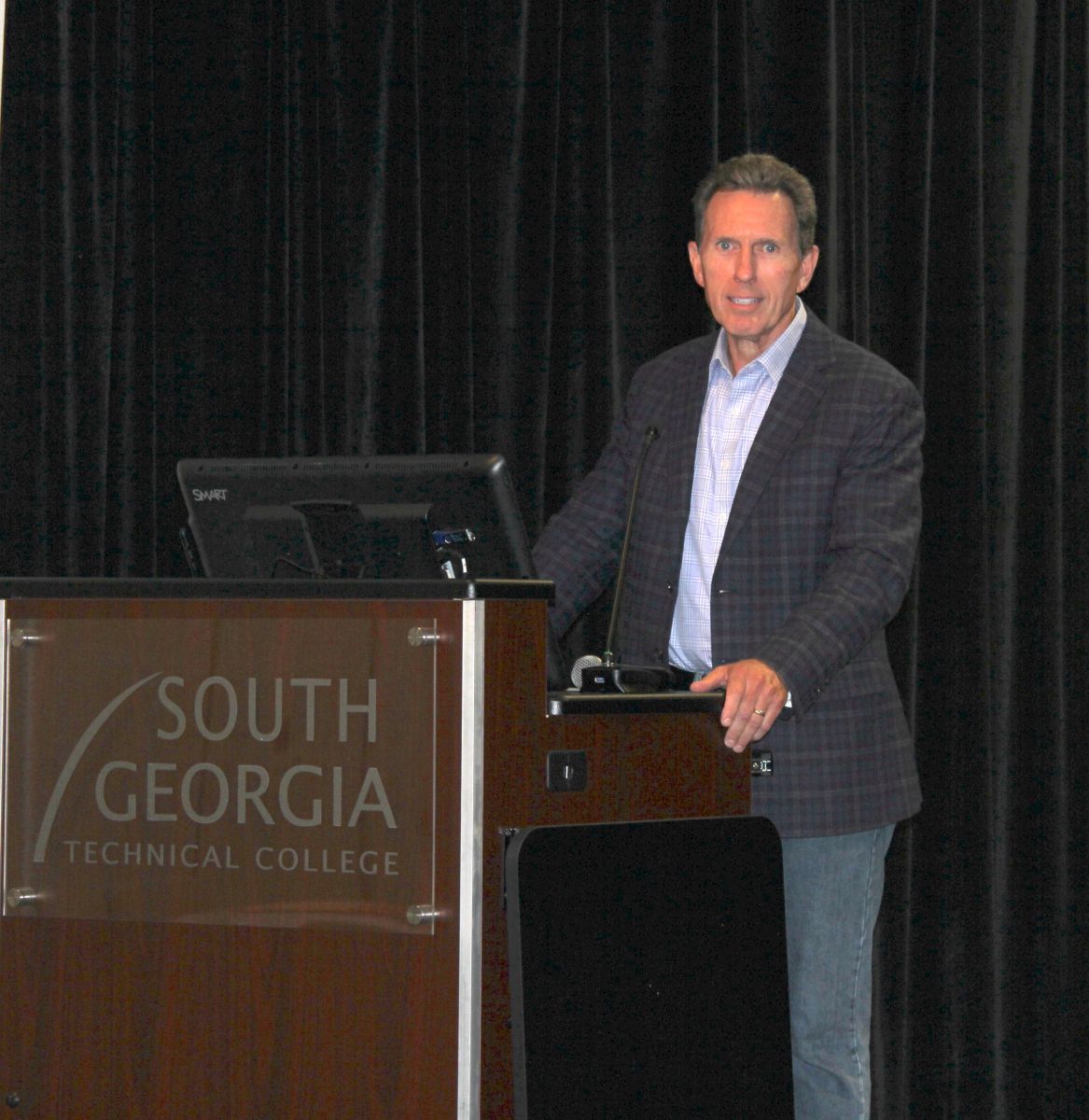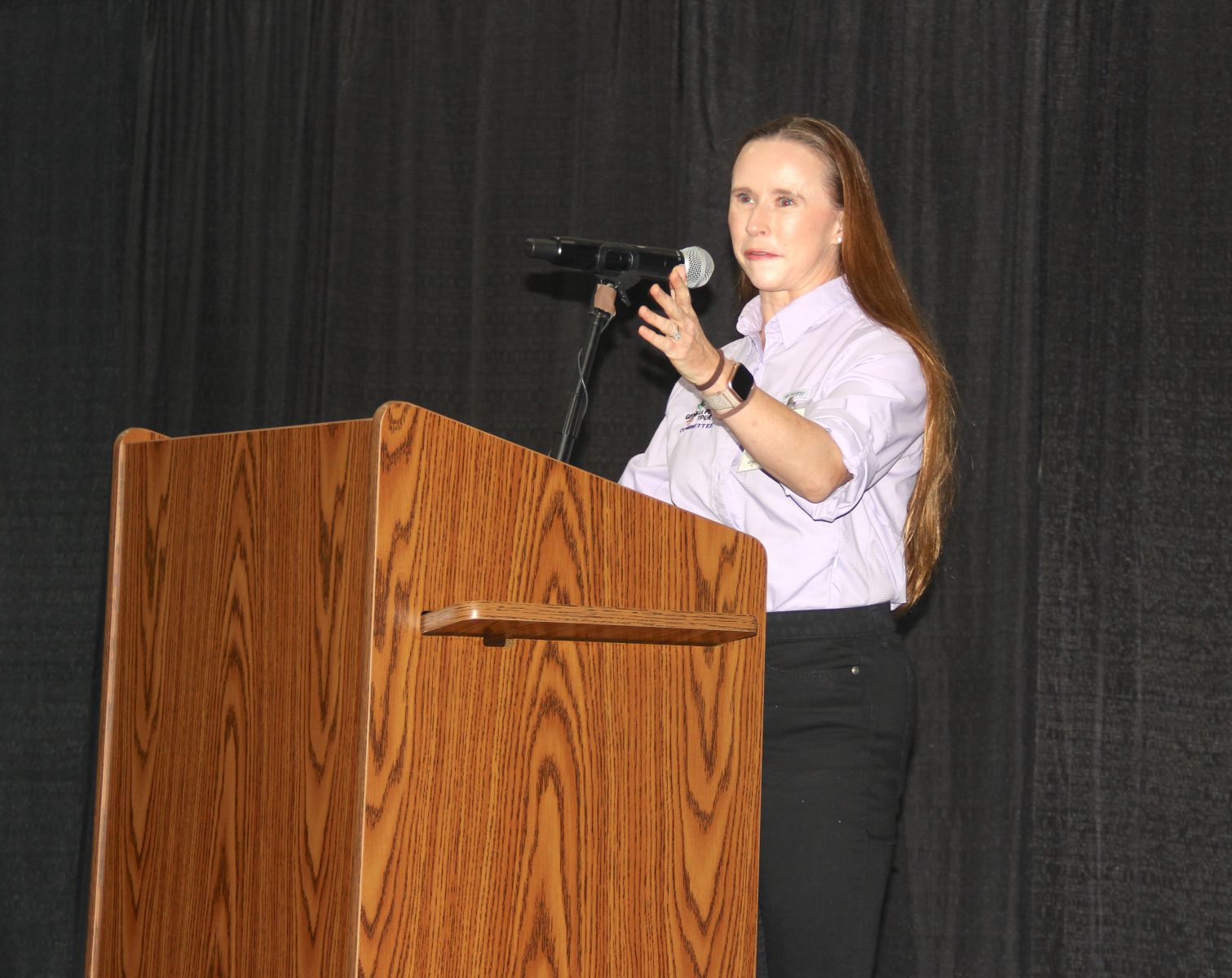Ag News
Cotton & peanut farm bill program changes; Sept. 30 deadline to swap cotton seed coverage for '25 crop
Posted on Sep 24, 2025 at 12:54 PM
Georgia cotton growers had the chance to attend eight different educational meetings held across the state Sept. 8-9 and Sept. 23 to learn how the One Big Beautiful Bill Act (OBBBA), signed into law July 4, will affect cotton farm bill programs. The meetings were hosted by the National Cotton Council (NCC) in collaboration with the Georgia Cotton Commission, Southern Cotton Growers and the Southeastern Cotton Ginners Association.
During the Hot Topics session of the 37th Annual Georgia Peanut Tour on Sept. 16, UGA Ag Economist Amanda Smith discussed the updated peanut farm bill provisions in the OBBBA.
National Cotton Council President & CEO Gary Adams discusses the new cotton program provisions in the OBBBA during a farm bill educational meeting held in Americus, Sept. 8. / Photo by Jennifer Whittaker
While speaking at the meeting held Sept. 8 in Americus, NCC President and CEO Gary Adams said the cotton industry has been working on improvements to the cotton farm bill program since 2022 when work first began on what was supposed to be the 2023 farm bill.
“It was about a three-and-a-half-year process to get this across the finish line, but we were fortunate to see essentially all of the industry priorities addressed in one way or another,” Adams said.
The 2018 farm bill has expired twice with Congress passing one-year extensions in 2023 and 2024 with the latest extension set to expire Sept. 30. The OBBBA updated many farm bill programs, but there are still some programs, such as conservation, that still need to be updated, which Congress and ag policy experts are referencing as the “skinny farm bill.”
According to the NCC, new cotton farm bill provisions in OBBBA include:
• an increase in seed cotton reference price to $0.42/lb
• payment limits increased & indexed to inflation
• marketing loan increased & modernized
• creation of an ELS loan similar to upland
• Supplemental Coverage Option changed to be more like STAX
• Basic & Optional Unit insurance premium subsidy increased
• Pima Trust Fund restored
• EAATM increased to highest level ever
UGA College of Agricultural & Environmental Sciences economist Amanda Smith discusses peanut program provisions during the Georgia Peanut Tour on Sept. 16. / Photo by Jennifer Whittaker
According to Smith, peanut provisions in the OBBBA include:
• Farmers will receive the higher of Price Loss Coverage (PLC) or Agriculture Risk Coverage (ARC) for the 2025 crop without having to do anything.
• Beginning with the 2026 crop, the PLC reference price for peanuts will increase from $535/ton to $635/ton.
• Beginning in 2031, reference price will increase by 1.005% up to 113% of the statutory reference price.
• ARC revenue guarantee will increase from 86% to 90% and the maximum payment will increase from 10% to 12% of benchmark revenue.
• Both PLC and ARC are allowed with Supplemental Coverage Option and Enchanced Coverage Option (ECO).
Sept. 30 deadline for growers to switch seed cotton program enrollment for ‘25/26 crop year
The farm bill provisions in the One Big Beautiful Bill Act increased the reference price for seed cotton to $0.42/lb beginning with the 2025/26 crop. That’s a 14% increase from the previous $0.367/lb for seed cotton. Growers enrolled in either ARC -CO or PLC for the 2025/26 crop will automatically receive the higher of the two payments regardless of their election for this crop year only.
Because some cotton producers purchased the Stacked Income Protection Plan (STAX) on farms with seed cotton base acres when the reference price was lower, USDA, in line with current Risk Management Agency policy, is allowing growers enrolled in STAX to switch their seed cotton base acres to Price Loss Coverage (PLC) or Agriculture Risk Coverage (ARC) for the 2025/2026 crop year. Sept. 30 is the deadline to make the new enrollment.
Growers who purchased STAX for the 2025/2026 crop year must pay a 60% premium penalty to enroll in PLC for the 2025/26 crop year. By enrolling in PLC and paying the 60% penalty, growers are waiving their right to a STAX indemnity for the 2025 crop.
Producers should contact their crop insurance agent to discuss whether changing their program is best for their farm. If growers opt out of STAX, they should be prepared to pay 60% of the STAX premium as a penalty. The National Cotton Council encourages producers to visit with their insurance agent before their appointment with FSA to enroll their seed cotton acres in PLC. Find your local USDA Service center here: https://offices.sc.egov.usda.gov/locator/app.
USDA Farm Service Agency offices will need the following if producers want to make this change on their farms.
• Completed Succession in Interest Contract; or
• Late Filed Enrollment
The following graph, provided by the National Cotton Council shows the difference in seed cotton PLC payments growers are expected to receive after the OBBBA increased the payment rate for the 2025/26 crop.
.jpg)
While speaking at the Americus meeting, Adams reminded growers that the seed cotton payment for the 2025/26 crop will not be issued until October 2026 because that is when the marketing year ends for the 2025/26 crop.
“We’re also well aware for a lot of growers, cost of production is probably in the 90-cent range and futures are trading in the 66 and 67 cent range. That’s the message we’re continuing to convey back to Washington. We've seen Secretary Brooke Rollins, Deputy Secretary Alexander Vaden and House Agriculture Committee Chairman GT Thompson talk about some type of short-term assistance,” Adams said. “I don't know if USDA has the funding left in the CCC to make the payments necessary or how things will play out in Congress, just know we [NCC] understand that a lot of producers are going to face challenges when those production loans come to you after harvest.”
Payment limits increased & indexed to inflation
Adams said payment limits for cotton ARC and PLC payments will increase from $125,000 to $155,000 per entity and will index to inflation in future years.
“I think the legislative language talks about the payment limits being indexed to the consumer price index,” Adams said. “So, two and a half to three percent growth per year, by the time you get to say 2030 that $155,000 probably looks a lot more like $175,000 to $178,000 if that’s the kind of inflation we’re going to continue to see.”
Smith said peanut growers will continue to have a separate payment limit for their peanut crop that was also increased from $125,000 to $155,000 per entity. The payment limit for peanuts will also be annually adjusted for inflation based on the consumer price index.
Certain entities, such as S-Corporations and LLCs will be treated the same as general partnerships with regards to the structure of payment limits for both cotton and peanuts.
Marketing loan changes
Beginning with the 2026 crop, the marketing loan rate for upland cotton will increase to $0.55/lb and extra-long staple (ELS) cotton will increase to $1/lb. The maximum storage credit rate for upland and ELS cotton will increase from the current $2.39 to $3 in Georgia and other cotton states, except California and Arizona. Another change is the marketing loan repayment rate for upland cotton will be the lowest 30-day prevailing market price beginning on the date the loan is repaid. This is expected to have an average benefit of 1.2 cents/lb.
The adjusted world price (AWP) used to determine loan rates will be calculated using the three lowest Far East quotes instead of the current five quotes. This is expected to have an average benefit of 60 cents/lb.
“I hope we get back to the point of where prices are such that none of this matters on the marketing loan, but if we're going to stay where we are on prices, then this is going to add some support, in time, to low prices,” Adams said.
For peanuts, Smith said that beginning with the 2026 crop, the peanut marketing loan rate will increase from $355/ton to $390/ton.
Opportunity to allocate new base acres
U.S. ag policy uses the concept of base acres for row crops that are covered by support payments in the farm bill. The number of base acres a farm has are based on its historic plantings of crops such as cotton, peanuts, soybeans, wheat and other eligible crops. Farmers haven’t had a chance to update their base acres since the 2014 farm bill, Smith said.
“This is the first time this has happened in a very, very long time,” Smith said. “For producers that planted crops in 2019 through 2023, if they have no base, they can add base to their farm. And for those producers that planted more than the base that they currently have, they could potentially increase the base on their farm.”
Under the ag provisions in the OBBBA, beginning with the 2026 crop, farmers will have a chance to claim new base acres predicated on their planting history of covered program commodities such as cotton, peanuts, corn, soy, wheat, sorghum, barley, oats, rice, minor oil, seeds, from 2019-2023.
Adams offered the NCC’s interpretation of how the allocation of new base acres will work and cautioned it may change once USDA issues final regulations. The farm bill provisions of the OBBBA allow no more than 30 million new base acres to be created on farms nationwide. If farmers submit more than 30 million acres nationwide then USDA FSA will prorate all submitted acres to get the nationwide total down to the 30 million cap, Adams said.
“This is all about what are we going to do with some new base acres that are created. Current base on a farm is not impacted. Whatever the current base on your farm is, whatever it’s assigned to – cotton, peanuts, corn, soy wheat, or any other covered commodity, those acres are going to stay unchanged on a farm,” Adams explained. “Did you plant a covered commodity from 2019 to 2023? Did you plant more acres on average than what you have base for the covered crop? If you answer yes to both of those questions, then based on the legislative language, you should be eligible for a base update. If you grew eligible non-covered commodities (specialty crops/vegetables) during the same time period, you will be allowed to add the number of acres of these crops as additional base acres as long as the total does not exceed 15% of the total acres on your farm. If your specialty crop acreage on a farm is greater than 15% of your total acres, they're only going to allow you to count 15% of those.”
To learn more about these and other cotton provisions in the OBBBA and to see examples of how new base allocations will be calculated, visit https://gfb.ag/NCCfbinfo.
Why having a farm bill that provides a safety net for farmers is crucial.
“Looking at the cost of production data for the past three decades, we’ve had eight periods where Georgia and Alabama peanut producers saw a positive value of production less total cost. In some of those years they saw profits on other crops like cotton or corn,” Smith said.
While farmers intentionally diversify to spread their risk out by growing multiple crops and livestock or poultry, Smith said unexpected factors such as severe weather or trade disputes that disrupt markets can disrupt the ag economy, lowering prices farmers receive.
“Producers in agriculture rely on the farm bill and government programs as a safety net because they can’t pivot as quickly and make changes to their operations to adjust to rapidly changing market conditions that are beyond their control,” Smith said.
- Categories:
- Tags:

